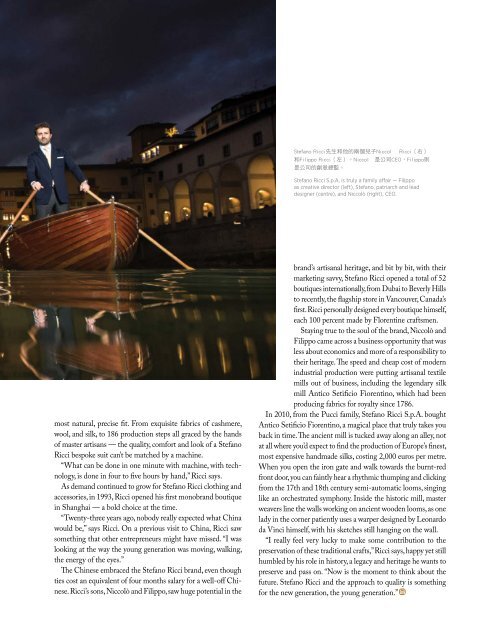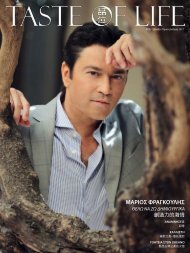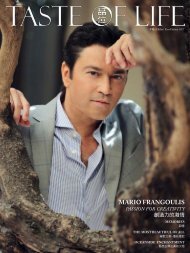Taste of Life Hellas 2018-19
Taste of Life - Hellas is the Greek version of Taste of Life - Canada. It is a luxury lifestyle magazine in Chinese and English in hardcopy and in Greek online at www.tasteoflifemag.gr. We believe luxury is something crafted with the heart and constant refinement. The beauty and intrinsic quality of luxury goods play an essential role in uplifting people’s values and inspiring growth, whether it’s automobile, leather goods, home decor, fashion, or cuisine. We craft our magazine to serve as the gateway for Asian immigrants to discover and appreciate Western values, and for Westerners to understand authentic Chinese culture.
Taste of Life - Hellas is the Greek version of Taste of Life - Canada. It is a luxury lifestyle magazine in Chinese and English in hardcopy and in Greek online at www.tasteoflifemag.gr. We believe luxury is something crafted with the heart and constant refinement. The beauty and intrinsic quality of luxury goods play an essential role in uplifting people’s values and inspiring growth, whether it’s automobile, leather goods, home decor, fashion, or cuisine.
We craft our magazine to serve as the gateway for Asian immigrants to discover and appreciate Western values, and for Westerners to understand authentic Chinese culture.
Create successful ePaper yourself
Turn your PDF publications into a flip-book with our unique Google optimized e-Paper software.
Stefano Ricci 先 生 和 他 的 兩 個 兒 子 Niccolò Ricci( 右 )<br />
和 Filippo Ricci( 左 )。Niccolò 是 公 司 CEO,Filippo 則<br />
是 公 司 的 創 意 總 監 。<br />
Stefano Ricci S.p.A. is truly a family affair — Filippo<br />
as creative director (left), Stefano, patriarch and lead<br />
designer (centre), and Niccolò (right), CEO.<br />
most natural, precise fit. From exquisite fabrics <strong>of</strong> cashmere,<br />
wool, and silk, to 186 production steps all graced by the hands<br />
<strong>of</strong> master artisans — the quality, comfort and look <strong>of</strong> a Stefano<br />
Ricci bespoke suit can’t be matched by a machine.<br />
“What can be done in one minute with machine, with technology,<br />
is done in four to five hours by hand,” Ricci says.<br />
As demand continued to grow for Stefano Ricci clothing and<br />
accessories, in <strong>19</strong>93, Ricci opened his first monobrand boutique<br />
in Shanghai — a bold choice at the time.<br />
“Twenty-three years ago, nobody really expected what China<br />
would be,” says Ricci. On a previous visit to China, Ricci saw<br />
something that other entrepreneurs might have missed. “I was<br />
looking at the way the young generation was moving, walking,<br />
the energy <strong>of</strong> the eyes.”<br />
The Chinese embraced the Stefano Ricci brand, even though<br />
ties cost an equivalent <strong>of</strong> four months salary for a well-<strong>of</strong>f Chinese.<br />
Ricci’s sons, Niccolò and Filippo, saw huge potential in the<br />
brand’s artisanal heritage, and bit by bit, with their<br />
marketing savvy, Stefano Ricci opened a total <strong>of</strong> 52<br />
boutiques internationally, from Dubai to Beverly Hills<br />
to recently, the flagship store in Vancouver, Canada’s<br />
first. Ricci personally designed every boutique himself,<br />
each 100 percent made by Florentine craftsmen.<br />
Staying true to the soul <strong>of</strong> the brand, Niccolò and<br />
Filippo came across a business opportunity that was<br />
less about economics and more <strong>of</strong> a responsibility to<br />
their heritage. The speed and cheap cost <strong>of</strong> modern<br />
industrial production were putting artisanal textile<br />
mills out <strong>of</strong> business, including the legendary silk<br />
mill Antico Setificio Fiorentino, which had been<br />
producing fabrics for royalty since 1786.<br />
In 2010, from the Pucci family, Stefano Ricci S.p.A. bought<br />
Antico Setificio Fiorentino, a magical place that truly takes you<br />
back in time. The ancient mill is tucked away along an alley, not<br />
at all where you’d expect to find the production <strong>of</strong> Europe’s finest,<br />
most expensive handmade silks, costing 2,000 euros per metre.<br />
When you open the iron gate and walk towards the burnt-red<br />
front door, you can faintly hear a rhythmic thumping and clicking<br />
from the 17th and 18th century semi-automatic looms, singing<br />
like an orchestrated symphony. Inside the historic mill, master<br />
weavers line the walls working on ancient wooden looms, as one<br />
lady in the corner patiently uses a warper designed by Leonardo<br />
da Vinci himself, with his sketches still hanging on the wall.<br />
“I really feel very lucky to make some contribution to the<br />
preservation <strong>of</strong> these traditional crafts,” Ricci says, happy yet still<br />
humbled by his role in history, a legacy and heritage he wants to<br />
preserve and pass on. “Now is the moment to think about the<br />
future. Stefano Ricci and the approach to quality is something<br />
for the new generation, the young generation.”




